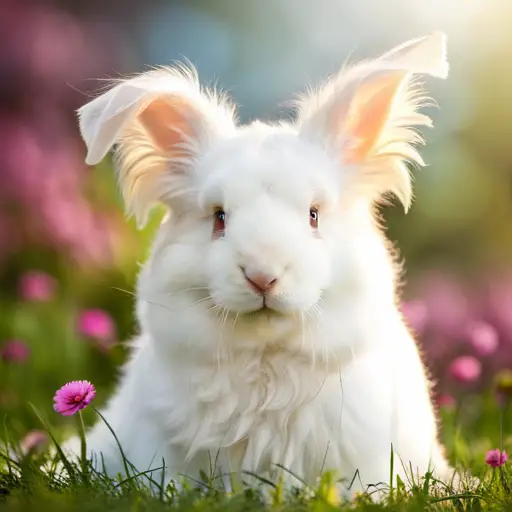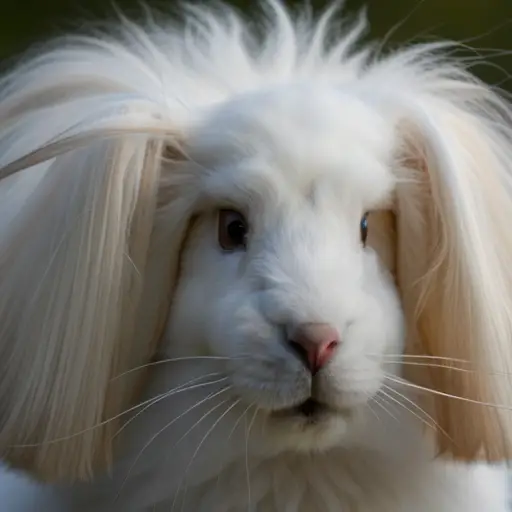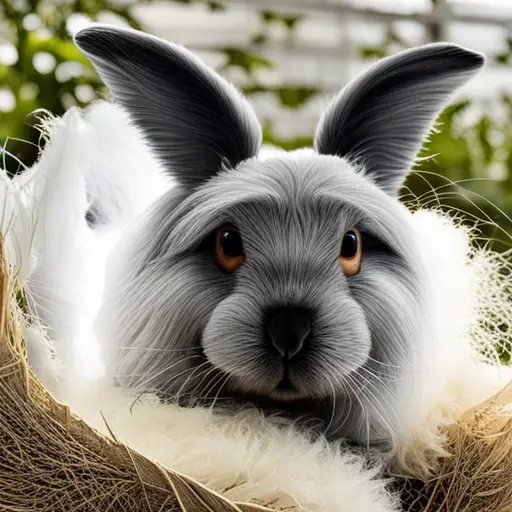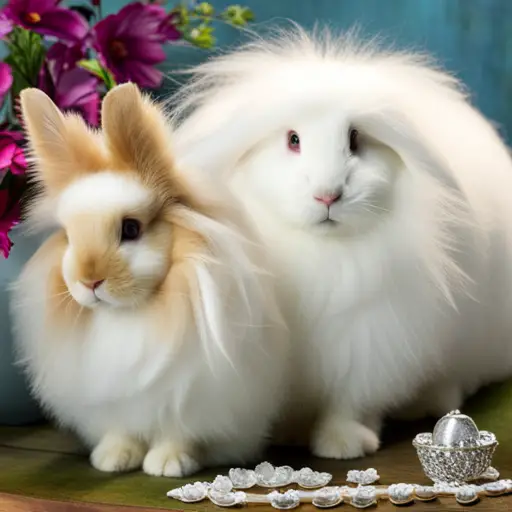The German Angora rabbit is an elegant breed known for its long, soft, and silky coat, which is sheared for angora wool. Traced back to the Ankara region of Turkey, angora rabbits have been bred for centuries for their high-quality fur. The German Angora is one of the largest angora breeds and produces the finest wool of all angoras.
With their cute faces and calm temperaments, German Angoras make wonderful pets that enjoy human companionship. Their grooming needs are higher than most rabbits, but their plush coats and affectionate natures make up for the extra care required. Read on to learn more about this fabulous fluffy breed.
Origins
From Ankara to Germany, The German Angora breed originated from the Ankara region of Turkey (formerly known as Angora). References to these long-haired rabbits date back to the early 1700s. Angora rabbits were introduced to Europe in the late 18th century, prized for their extraordinarily soft wool.
Germany began focused breeding programs to improve the breed in the early 1900s, selecting for rabbits with the densest, highest quality fur. This led to the development of the German Angora breed we know today.
German Angoras were first imported to the United States in the 1920s. They are recognized by the American Rabbit Breeders Association (ARBA) but are considered a rare breed. There are estimated to be less than 500 German Angora rabbits in the U.S. today.
Appearance – Elegant and Distinctive Long-Haired Look
The most distinguishing feature of the German Angora is its thick, plush coat, which requires constant grooming. The fur consists of three types of hair:
- Undercoat – The soft, dense undercoat grows close to the skin and produces the silky wool.
- Awn Hair – Longer and coarser awn hairs grow through the undercoat, providing structure and protection.
- Guard Hairs – The outermost guard hairs are the longest and give the coat a smooth finish.
The fur is 2-4 inches in length, with the belly and feet fur slightly shorter. When groomed properly, the coat parts naturally down the spine and fans out to the sides in breeze-catching waves.
German Angoras have compact, commercial-type bodies weighing 7-10.5 lbs. The head is rounded with upright ears about 2.5 inches long. Their eyes are bold and bright. Recognized coat colors include ruby-eyed white, blue, black, chocolate, lilac, and many more. The variety of colors is one reason they are popular as pets.
Grooming Needs – Significant But Rewarding
With their long coats, German Angoras require a greater time commitment for grooming than most rabbit breeds. During molting seasons (typically spring and fall), they should be brushed thoroughly every day to prevent ingested wool from causing health issues. The rest of the year, brushing 2-3 times per week is ideal.
Many owners enjoy the relaxing grooming ritual with their bunny. It strengthens the human-rabbit bond through gentle handling. Owners should invest in a few specific grooming tools:
- Slicker Brush – Removes loose hair and prevents mats close to the skin.
- Comb – Untangles longer fur and guard hairs.
- Blower – Dries the thick coat after a bath.
- Trimming shears – Keep the fur neat around the feet, eyes, and bottom.
German Angoras should be bathed occasionally using a gentle rabbit shampoo. Bathing loosens and removes excess fur. The thick coats take considerable time to dry fully, so blow drying prevents health issues. With proper grooming maintenance, these rabbits can be veritable fluff balls of elegance.
Temperament – Calm and Affectionate
Despite their diva-like grooming needs, German Angoras have wonderfully calm and docile personalities. They tend to be less active than some rabbits, content to snuggle with their families for hours. Handled frequently from a young age, they become very comfortable around people.
As prey animals, they may initially be shy or frightened by loud noises and quick movements. But with time and patience, German Angoras warm up and bond strongly with their owners. They will often happily sit in a lap for petting and brushing sessions. Many enjoy being cuddled and cradled like a baby.
Their peaceful temperaments make German Angoras excellent pets for rabbit lovers of all ages. They get along well with respectful children and other pets when properly introduced. Of course, supervision is always recommended when small children interact with any rabbit.
As social animals, German Angoras should not be kept alone or housed solely in outdoor hutches. They thrive on companionship and playtime, preferably with a bonded mate or human family. With positive interactions, they become trusting lifelong friends.
Housing and Exercise Needs
German Angoras are relatively inactive, but housing should provide some opportunities for exercise. A roomy hutch, cage, or pen is ideal, the larger the better. Wire flooring should be avoided, as it can cause painful foot sores. A grass mat, carpet, or towel placed over any wire areas makes a more comfortable surface.
The enclosure should contain hiding spots, ramps, tunnels, chew toys, and litter boxes to satisfy natural behaviors. Safe time in rabbit-proofed rooms or yards allows additional exercise and mental stimulation. Supervision is still required during free-range time given their tendency to chew.
German Angoras prefer cooler temperatures below 75°F and should be housed indoors. Heat can cause them distress and potentially dangerous molting. Air conditioning, fans, frozen water bottles, and tile flooring help keep these fluffy rabbits comfortable in warmer weather.
Giant angora breeds also have higher nutritional requirements due to their rapid wool growth. A diet of grass hay, leafy greens, and a small amount of pellets ensures they receive sufficient fiber and nutrients. Fresh water should always be available.
Health and Lifespan
With proper care, German Angoras live 8-12 years, slightly longer than most domestic rabbits. Their thick coats require vigilant grooming to prevent issues like:
- Wool block – Occurs when ingested wool accumulates in the stomach. Frequent brushing and occasionally administering hairball remedies reduce this risk.
- Flystrike – Flies are attracted to soiled fur near the bottom which can lead to maggot infestation. Keeping the hindquarters clean is crucial.
- Heat stress – Excessive heat can cause life-threatening molting and GI stasis. Air conditioning, fans, and frozen water bottles help keep them cool.
- Sore hocks – Wire flooring can irritate feet and lead to infected sores. Padding wire cages provides cushioned comfort.
Aside from grooming-related disorders, German Angoras are not prone to genetic conditions seen in some breeds. With attentive care, regular vet checkups, and a loving home, these gentle giants can live a long, healthy, and happy life.
Finding a German Angora Rabbit
The rarity of German Angoras makes finding one challenging. Ask local rabbit breeders if they have angora litters or waitlists. Attending rabbit shows provides a chance to connect with breeders and fanciers. Be sure to thoroughly vet any online sources.
Expect to pay 75-200+ for a German Angora from a reputable breeder. Show-quality rabbits are pricey due to high demand. Adoption fees are usually lower if you can locate one through a shelter or rescue. Patience may be required to find this uncommon breed.
Considerations Before Bringing One Home
German Angoras require more effort than typical rabbits. Ask yourself these questions before deciding if the breed is right for you:
- Do I have at least 1-2 hours per week to devote to brushing?
- Can I commit to a thorough daily grooming during molts?
- Am I prepared to keep the thick coat well-groomed year-round?
- Can I provide an indoor area cooled below 75°F for this heat-sensitive breed?
- Do I have the budget for grooming tools, higher food intake, and potential vet bills?
If you can meet a German Angora’s substantial grooming needs, they make marvelously mellow yet eye-catching companions. They’ll reward your diligent care by blossoming into the loveliest little fur balls imaginable.
The Luxurious German Angora Wool
The sumptuously soft, long fur of German Angoras produces the highest grade angora wool. Their coats are usually sheared twice yearly, yielding around 5-8 ounces per shearing. Skilled hand spinners transform the wool into deliciously warm yet breathable yarn.
Angora wool blends well with other fibers like silk or cashmere. It is exceptionally lightweight and insulating with a heavenly silken texture. The wool lacks natural oils, meaning garments do not absorb odors. German angora is often described as seven times warmer than sheep’s wool yet lighter than cashmere.
Some small farms specialize in raising and shearing German Angoras, then selling the fiber for hand spinning. More commonly, rabbit owners shear their companions themselves and spin the wool for personal projects or sale on a small scale. Angora yarn produced this way is highly sought after by knitters, crocheters, and weavers.
Final Words!
Whether kept as a beloved pet or producer of luxury fiber, the German Angora is a fabulous rabbit breed like no other. Their distinctive long coats and gentle personalities make them stand out among the rest. For devoted owners willing to invest ample time into grooming, they are truly a special treasure of the rabbit world.




